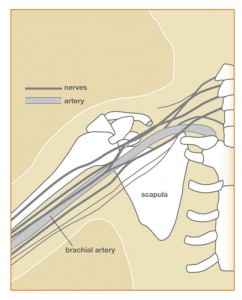How do I know if I have a Brachial Plexus injury?
Brachial Plexus injuries occur most often when a person is involved in a severe road traffic accident. More often than not Motorcyclists who are thrown from their bike or fall from a height suffer this type injury. The severity of the damage however is determined by the position of the arm as they fall.
Common symptoms associated with a Brachial Plexus injury include:
- Neck Pain
- Swelling in the shoulder region
- Weakness in the arm you have damaged ranging from pins and needles to complete loss of use
- Broken collarbone
(It is important to note, these symptoms may not be present at the time of injury.)
These symptoms are all possible indicators of a more serious injury as they occur in the same C5-T1 nerve region as the Brachial Plexus. Whilst getting any symptom you may think is indicative of brachial plexus checked out at the Doctor, there are some simple tests you can do at home to check.
Checking the nerves:
Simply pinch the nail base of your thumb, middle and little finger and pull outwards. If your nail burns your nerves are continuing to function. If no burning is felt it is worth visiting your Doctor immediately and explaining your findings.
Checking your motor skills:
Assess for yourself your level of maneuverability of the arm. Can you move from the elbow down in all directions? Can you flex your wrist? Can you stretch and flex your fingers? Anything you feel is out of the ordinary is worth mentioning at your Doctors appointment.
Brachial plexus injuries can have a long-term knock on effect to the functionality of your arm. If this injury is caused as a result of a motor vehicle accident it is possible to make a Brachial Plexus compensation claim.
Be the first to comment on "A Guide To Brachial Plexus Compensation"